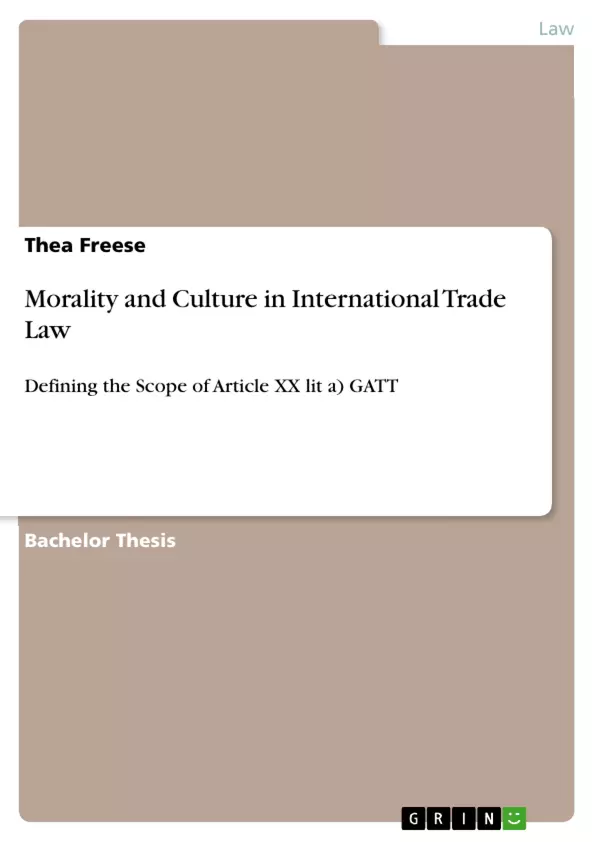In 2009 the WTO Panel China-Audiovisual Products was the first to rule on an Article XX lit a) GATT defence used to legitimize trade restrictions on moral grounds. So far countries have been reluctant to employ the vaguely defined public morals clause, but trends suggest that an augmented use is to be expected. The WTO has provided little indication as to which and whose morals are covered by the exception which has led to the widespread fear that the public morals clause might be abused to enforce unilateral policies against the principles of free trade.
This paper takes an abstract approach to the scope and content of the public morals exception of the GATT. Critically examining the drafting history, legal practice and current scholarly research the note concludes that a large variety of different values are covered by the concept of public morality. However the note suggests that an abuse of the exception is not to be expected as the high boundaries set by the WTO to the application of the exception render the legalization of most policy objectives highly unlikely.
Inhaltsverzeichnis (Table of Contents)
- Introduction
- Research Problem
- Relevance of the Topic
- Scope of the Study
- China-Audiovisual Products (WT/DS363)
- The Dispute
- China's Legalization under Article XX lit a) GATT
- Content and Scope of Article XX lit a) GATT
- Vienna Convention on the Interpretation of Treaties
- Ordinary Meaning
- Object and Purpose
- Context
- Preparatory Work
- Prior Treaties
- Perceived Need
- Moral Trade Restrictions in Enforcement
- Scholarly Research
- The Question of Extraterritoriality
- Summary
- Boundaries to the Application of the Public Morals Clause
- Burden of Proof
- Means of Evidence
- Originalism
- Universalism
- Moral Majority
- Unilateralism
- Necessity Test
- Chapeau Clause of Article XX GATT
- Conclusion
- Summary
- Outlook
Zielsetzung und Themenschwerpunkte (Objectives and Key Themes)
This paper examines the scope and content of the public morals exception in the General Agreement on Tariffs and Trade 1994 (GATT) by exploring the legal history, practice, and academic research surrounding this clause. It aims to shed light on the range of values encompassed by the concept of public morality and address concerns surrounding the potential abuse of the exception in international trade.
- Understanding the content and scope of the public morals exception within the framework of Article XX lit a) GATT.
- Analyzing the historical development and application of the public morals exception through case law and scholarly interpretations.
- Assessing the boundaries and limits to the application of the public morals exception in international trade disputes.
- Exploring the potential for the public morals exception to be misused for protectionist or unilateral purposes.
- Examining the relationship between free trade principles and national sovereignty in the context of the public morals exception.
Zusammenfassung der Kapitel (Chapter Summaries)
- Introduction: The chapter introduces the research problem by examining the WTO dispute WT/DS363 China-Audiovisual Products, where China invoked Article XX lit a) GATT to justify trade restrictions on cultural goods. The significance of the public morals exception in the context of globalization, cultural diversity, and the potential for trade protectionism is discussed.
- China-Audiovisual Products (WT/DS363): This chapter provides a detailed analysis of the WTO dispute involving China's restrictions on audiovisual products. It examines China's legal justification for its actions under Article XX lit a) GATT and the WTO Panel's decision on the case.
- Content and Scope of Article XX lit a) GATT: This chapter delves into the meaning and interpretation of Article XX lit a) GATT through an examination of the Vienna Convention on the Interpretation of Treaties. It analyzes the ordinary meaning, object and purpose, and context of the clause, considering preparatory work, prior treaties, perceived need, and scholarly research on public morality.
- Boundaries to the Application of the Public Morals Clause: This chapter explores the limits and constraints placed on the use of the public morals exception in international trade. It examines the burden of proof required for invoking the exception, the various means of evidence used, and the necessity test applied in WTO disputes.
Schlüsselwörter (Keywords)
This paper explores the intricate relationship between international trade and the public morals exception within the WTO framework. Key concepts include Article XX lit a) GATT, public morals, cultural goods, protectionism, sovereignty, trade restrictions, dispute settlement, Vienna Convention on the Interpretation of Treaties, and extraterritoriality.
- Quote paper
- Thea Freese (Author), 2010, Morality and Culture in International Trade Law, Munich, GRIN Verlag, https://www.grin.com/document/159686



